Causes of the Tsushima disaster
23 May 1905 Squadron Rozhestvensky made the last loading of coal. The reserves were again exceeded; as a result, the battleships were overloaded, plunging deep into the sea. 25 May all the extra transports were sent to Shanghai. The squadron was put on full alert. Rozhdestvensky intelligence is not organized, so as not to detect the squadron.
However, the Japanese already guessed which way the Russian ships would go. The Japanese admiral of Togo has been waiting for Russian ships since January 1905. The Japanese command assumed that the Russians would try to break into Vladivostok or capture some harbor in the Formosa region (present-day Taiwan) and from there conduct operations against the Japanese Empire. At a meeting in Tokyo, it was decided to proceed from the defense, concentrate forces in the Strait of Korea and act on the situation. Waiting for Russian fleet the Japanese carried out a major overhaul of the ships, replaced all the faulty guns with new ones. Previous battles made the Japanese fleet a single combat unit. Therefore, by the time the Russian squadron appeared, the Japanese fleet was in the best condition, unified, with great combat experience, a formation that was encouraged by previous successes.
The main forces of the Japanese fleet were divided into 3 squadrons (each with several detachments). The 1 squadron was commanded by Admiral Togo, who held a flag on the battleship Mikaso. In the 1 combat detachment (armored core of the fleet) there were 4 squadrons of 1 class battleships, 2 1 class armored cruisers and a mine cruiser. The 1 squadron also included: 3 combat squadron (4 armored cruiser 2 and 3 grades), 1 squadron destroyers (5 destroyers), 2 th destroyer squad (4 units), 3 units, 4 destroyers. destroyers squadron (14 ship), 4-th detachment of destroyers (2 destroyer). The 2 squadron was under the flag of Vice Admiral H. Kamimura. It consisted of: 6-th combat squad (1 class 4 armored cruisers and advices), 4-th combat squad (4 armored cruisers), 5-I and 4-th destroyer squads (on 9 ship, X-ray armored cruisers, 19-I and 3-th destroyers (for 3 ship), 5-th and 3 squadrons (for 2 ship), 6-th combat crews th and 4-th units destroyer. 3-I squadron under the flag of Vice Admiral S. Kataoka. The 7 squadron consisted of: 3 combat squadron (obsolete battleship, 4 cruiser 1 class, advice notes), 5 battle squadron (10 X-class armored cruisers), 11 battle squadron, 15 battle squadron of 17 class cruisers , 18 class cruiser, 20 gunboats), 4, 16, 2, XNUMX, XNUMX, XNUMX, XNUMX and XNUMX of the destroyers (XNUMX units), XNUMX-th detachment of destroyers (XNUMX destroyer), a detachment of special purpose ships (it included auxiliary cruisers).
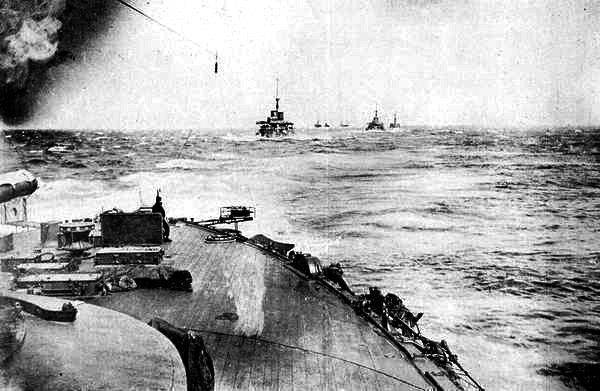
Japanese fleet goes to meet the 2 th Pacific squadron
The balance of power was in favor of the Japanese. For linear armored ships was approximate equality: 12: 12. For large-caliber guns in mm 300 (254 — 305 mm), the advantage was on the side of the Russian squadron - 41: 17; on the other guns, the Japanese had the advantage: mm 200 - 6: 30, mm mm 150 - 52: 80. The Japanese had a great advantage in such important indicators as the number of shots per minute, weight in kg of metal and explosives. On the 300-, 250- and 200 mm guns, the Russian squadron fired 14 rounds per minute, the Japanese 60; metal weight was in Russian guns 3680, the Japanese - 9500 kg; the weight of the explosive in Russians, in Japanese - 1330 kg. The Russian ships were also inferior in the segment of 150 and 120 caliber guns. By the number of shots per minute: Russian ships - 120, Japanese - 300; the weight of the metal in kg for Russian guns is 4500, for the Japanese it is 12350; Russian explosives have 108, Japanese have 1670. The Russian squadron was also inferior in terms of armor: 40% versus 60% and speed: 12-14 nodes versus 12-18 nodes.
Thus, the Russian squadron was inferior in speed of fire in 2-3 times; by the amount of metal ejected per minute, Japanese ships were superior to Russians in 2 1 / 2 times; The stock of explosives in Japanese shells was more in 5-6 times than in Russian. Russian thick-walled armor-piercing shells with extremely low bursting charge pierced Japanese armor and did not explode. Japanese shells produced severe damage and fires, literally destroying all non-metallic parts of the ship (there was an excess of wood on the Russian ships).
In addition, the Japanese fleet had a significant advantage in light cruising forces. In a direct cruising battle, the Russian ships were threatened with complete defeat. They were inferior in the number of ships and guns, and were also connected by the protection of transports. The Japanese had a huge superiority in the carrying forces: the 9 Russian 350-ton destroyers against the 21 destroyer and the 44 destroyer of the Japanese fleet.
After the appearance of the Russian ships in the Strait of Malacca, the Japanese command received accurate information about the movement of the 2 Pacific Squadron. In the middle of May, the cruisers of the Vladivostok detachment went out to sea, indicating that the Russian squadron was approaching. The Japanese fleet prepared to meet the enemy. The 1 and 2 squadrons (armored fleet core of 4 squadron battleships of the 1 class and 8 armored cruisers of the 1 class, almost equal in power to the battleships) are located on the western coast of the Korean Strait, in Mozampo; 3-I squadron - near the island of Tsushima. Auxiliary cruisers from the merchant steamships made up an 100 miles guard chain spread out 120 miles south of the main forces. Behind the watchdog, light cruisers and patrol ships of the main forces were stationed. All forces were connected by wireless and guarded the entrance to the Korean Gulf.
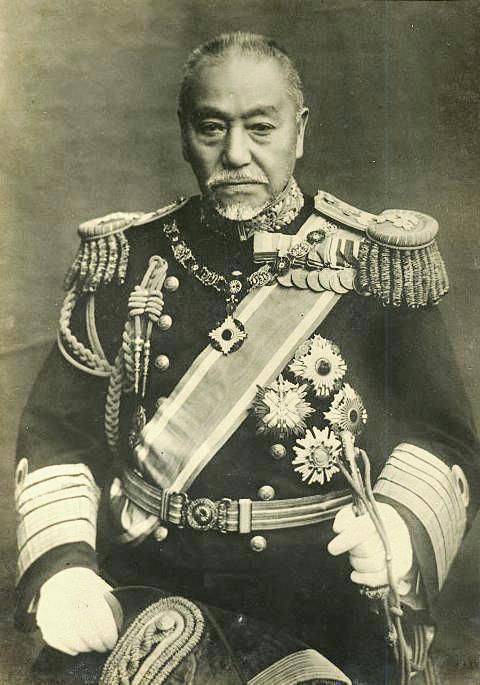
Japanese Admiral Togo Kheyhatiro
Squadron battleship Mikasa, July 1904 of the year
Squadron battleship "Mikasa", aft tower repair. Reid Elliot, 12-16 August 1904 of the year
Sikishima squadron battleship, July 6 1906
Squadron battleship "Asahi"
On the morning of May 25, the squadron of Rozhestvensky headed for the Tsushima Strait. The ships went in two columns with vehicles in the middle. On the night of May 27, the Russian squadron passed the Japanese watchdog chain. The ships went without lights and were not seen by the Japanese. But, following the squadron 2 hospital ship were lit. In 2 hour. 25 min. they were noticed by the Japanese cruiser, having remained undetected. At dawn, the Russian squadron first came out alone and then several enemy cruisers, who followed at a distance and at times disappeared in the morning mist. Around 10, the squadron of Rozhestvensky was reorganized into a single wake column. Transports and auxiliary ships under cover of 3 cruisers moved behind.
In 11 hour. 10 min. Japanese cruisers appeared from behind the fog, some Russian ships opened fire on them. Rozhestvensky ordered to stop firing. At noon, the squadron headed north-east 23 ° - to Vladivostok. Then the Russian admiral tried to rebuild the right column of the squadron in front of the system, but, again seeing the enemy, refused this idea. As a result, the armadillos were in two columns.
Togo, having received a report in the morning about the appearance of the Russian fleet, immediately moved from Mozampo to the eastern side of the Korea Strait (Okinoshima Island). From the intelligence reports, the Japanese admiral knew perfectly well the deployment of the Russian squadron. When at about noon the distance between the fleets was reduced to 30 miles, Togo moved towards the Russians with the main armored forces (12 squadron battleships and armored cruisers) plus 4 light cruisers and 12 destroyers. The main forces of the Japanese fleet were to attack the head of the Russian column, and the cruising forces of Togo sent around the Russian rear to capture the transports.
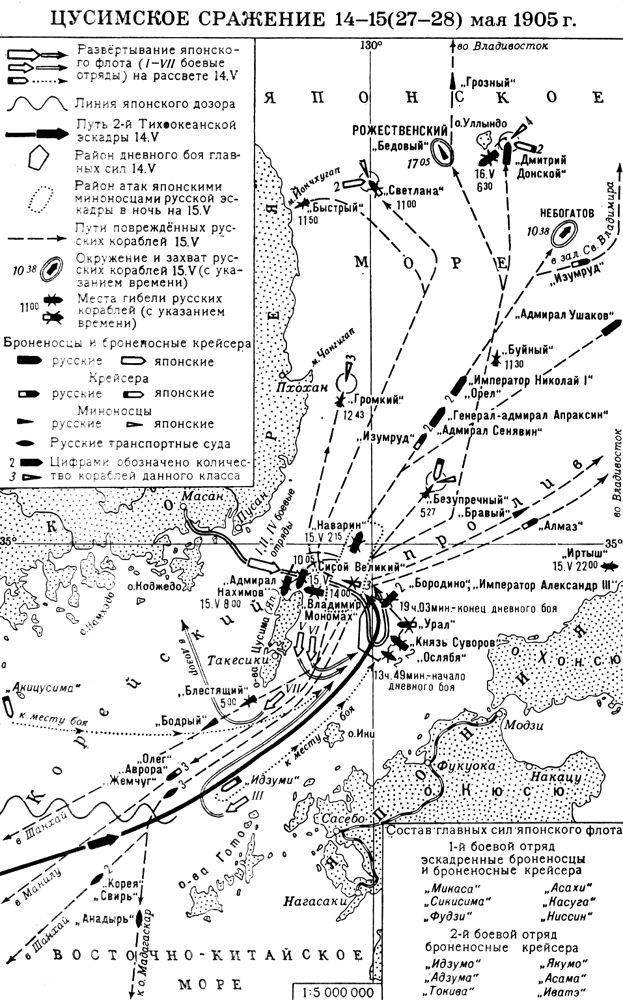
In 13 hour. 30 min. the right column of the Russian battleships increased the course to 11 nodes and began to dodge to the left in order to reach the head of the left column and form a common column. Cruisers and transports were instructed to depart to the right. At that moment, the ships of Togo appeared from the northeast. The Japanese ships, having a course in 15 nodes, went across the path of the Russian squadron and, being ahead and somewhat to the left of our ships, began sequentially (one after the other at one point) to turn in the opposite direction - the so-called “Togo loop”. Thus, Togo took a position ahead of the Russian squadron.
The turning point was very risky for the Japanese. Rozhestvensky got a good chance to turn the tide in his favor. Having accelerated the move of the 1 squad to Maxim, having come close to the 15 cable distance, which was usual for Russian commanders, and concentrating fire on the turning point of the squadron of Togo, the Russian squadron battleships could shoot the enemy. According to a number of military researchers, such a maneuver could cause serious damage to the armored core of the Japanese fleet and allow the 2 Pacific squadron, if not to win this battle, then at least accomplish the task of breaking through the main forces to Vladivostok. In addition, the newest Russian battleships of the Borodino type could try to "squeeze" Japanese ships to a column of older Russian battleships, slow, but with powerful tools. However, Rozhestvensky either did not notice this, or did not dare to take such a step, not believing in the capabilities of his squadron. And he had very little time to make such a decision.
At the time of turning the Japanese squadron into 13 hour. 49 min. Russian ships opened fire from a distance of about 8 km (45 cable). At the same time, only the head battleships could effectively hit the enemy, for the rest the distance was too great, and the ships in front hampered. The Japanese responded immediately, concentrating the fire on two flagships, Prince Suvorov and Oslyab. The Russian commander turned the squadron to the right to take a position parallel to the course of the Japanese fleet, but the enemy, using greater speed, continued to cover the head of the Russian squadron, blocking the way to Vladivostok.
Approximately in 10 minutes the Japanese commanders were adjusted and their powerful high-explosive shells began to produce great damage on the Russian ships, causing severe fires. In addition, fire and strong smoke made it difficult for the Russians to shoot and disrupt control of the ships. Oslyabya was badly damaged and about an hour. 14 min. buried his nose right up to the gates, rolled out of order to the right, after about 30 minutes the battleship overturned and sank. The commander of the 10 rank captain Vladimir Baer was wounded at the beginning of the battle and refused to leave the ship; more than 1 people were killed along with him. Destroyers and tug lifted out of the water 500 people. At about the same time, Suvorov was severely damaged. Fragments of the projectile fell into the wheelhouse, interrupting and wounding almost everyone who was there. Rozhestvensky was injured. Having lost control, the battleship rolled to the right, and then dangled between squadrons, trying to regain control. In the course of further battle, the battleship was fired several times, attacked with torpedoes. At the start of the 376 hour. the destroyer "Violent" removed from the ship part of the headquarters headed by seriously wounded Rozhestvensky. Soon the Japanese cruisers and destroyers finished off the crippled flagship. The whole crew died. When the battleship Suvorov was killed, Admiral Nebogatov took command, holding a flag on the squadron battleship Emperor Nicholas I.
I.A. Vladimirov. The heroic death of the battleship "Prince Suvorov" in the Tsushima battle
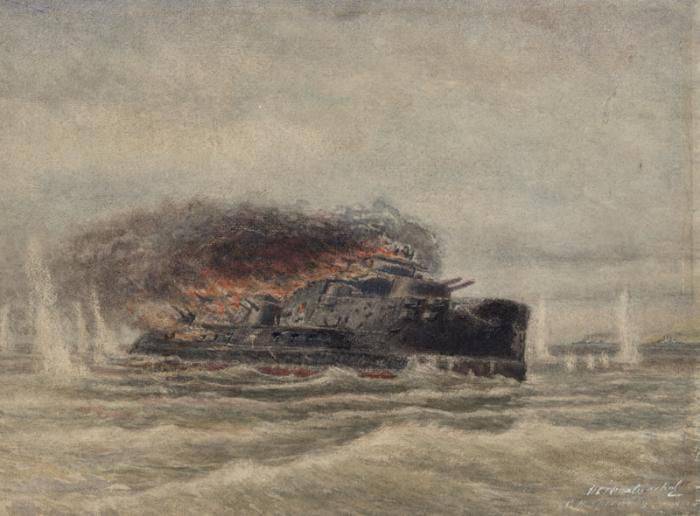
I.V. Slavinsky. The last hour of the battleship "Prince Suvorov" in the Tsushima battle
The squadron was headed by the next battleship - "Emperor Alexander III". But soon he received severe injuries and moved to the center of the squadron, giving Borodino a leading position. Finished battleship "Alexander" in 18 hour 50 min. concentrated fire armored cruisers "Nissin" and "Kassuga." None of the crew (857 people) survived.
Russian squadron continued to move in a relative order, trying to escape from the Japanese ticks. But the Japanese ships, without serious damage, still blocked the way. About 15 hour. Japanese cruisers went to the rear of the Russian squadron, captured two hospital ships, started a battle with the cruisers, knocking down cruisers and transports in one pile.
After 15 an hour. the sea suddenly closed the fog. Under his protection, the Russian ships turned to the south-east and separated from the enemy. The battle was interrupted, and the Russian squadron again fell on the course of the north-east 23 °, in the direction of Vladivostok. However, the enemy cruisers discovered the Russian squadron and the battle continued. An hour later, when the fog reappeared, the Russian squadron turned south and drove the Japanese cruisers away. In the 17 hour, obeying the instructions of Rear Admiral Nebogatov, Borodino again led the convoy to the northeast, towards Vladivostok. Then the main forces of Togo approached again, after a short skirmish, the fog divided the main forces. About 18 hour. Togo again caught up with the main Russian forces, concentrating fire on Borodino and Orel. Borodino suffered severe injuries and burned. At the start of the 19 hour. "Borodino" received the last critical damage, was all on fire. Battleship capsized and sank with the whole crew. Saved only one sailor (Semen Yushchyn). “Alexander III” died a little earlier.
With the sunset, the Japanese commander took the ships out of battle. By the morning of May 28 all the detachments were to gather north of the Dagelet Island (in the northern part of the Korea Strait). The miners received the task of continuing the battle, encircling the Russian squadron and completing the rout by night attacks.
Thus, 27 in May 1905, the Russian squadron suffered a heavy defeat. 2-I Pacific squadron lost 4 best squadron battleship of 5-ti. The newest battleship Eagle, which remained afloat, was badly damaged. Other ships of the squadron were also heavily damaged. Many Japanese ships received several holes, but retained their combat capability.
The passivity of the Russian command, which did not even attempt to defeat the enemy, went into battle without any hope of success, surrendering to fate, led to the tragedy. The squadron only tried to break into the direction of Vladivostok, and did not lead a decisive and furious battle. If the captains were resolutely fighting, maneuvering, trying to get close to the enemy for effective shooting, the Japanese would have suffered much more serious losses. However, the passivity of the leadership paralyzed almost all commanders, the squadron, like a herd of bulls, stupidly and stubbornly, rushed towards Vladivostok, not trying to crush the Japanese ship.
Squadron battleship "Prince Suvorov"
The squadron battleship "Oslyabya" in the campaign to the Far East as part of the 2 Pacific Squadron
Oslabya squadron battleship in front of the Korean Strait, May 1905
Ships 2-th squadron during one of the stops. From left to right: squadron battleships Navarin, Emperor Alexander III and Borodino
Squadron battleship "Emperor Alexander III"
Completion of the pogrom
At night, numerous Japanese destroyers surrounded the Russian fleet from the north, east, and south. Nebogatov on his flagship overtook the squadron, became in my head and moved to Vladivostok. Cruisers and destroyers, as well as the surviving transports, not having received the task, headed in different directions. The 4 battleships remaining at Nebogatov (“Nikolai”, “Eagle”, “Admiral Senyavin”, “General-Admiral Apraksin”) in the morning were surrounded by superior enemy forces and capitulated. Crews were ready to take the last battle and die with honor, but they fulfilled the order of the admiral.
Only the Izumrud cruiser, which was the only cruiser remaining in the squadron after the battle and guarding the remnants of the 2 Pacific Squadron from the destroyers' attacks at night, did not obey the order to surrender to the Japanese. "Emerald" at full speed broke through the encirclement and went to Vladivostok. The captain of the ship, 2 rank captain Vasily Ferzen, who performed well during this tragic battle and breaking through the ring of encirclement, made a number of serious mistakes on his way to Vladivostok. Apparently, the impact of psychological stress of the battle. When entering the Gulf of Vladimir, the ship sat on the stones and was blown up by the crew, fearing the appearance of the enemy. Although at high tide it was possible to remove the ship from the shoals.
The battleship Navarin did not suffer much damage during the day battle, the losses were small. But the night he gave himself the light of searchlights, and the attack of the Japanese destroyers led to the death of the ship. Of the crew member 681, only three managed to escape. The battleship Sisoy the Great suffered heavy damage during the day battle. At night, she was attacked by destroyers and received fatal damage. In the morning, the battleship reached the island of Tsushima, where it collided with Japanese cruisers and a destroyer. The commander of the ship M. V. Ozerov, seeing the hopelessness of the situation, agreed to surrender. The Japanese evacuated the crew, and the ship sank. The armored cruiser "Admiral Nakhimov" was seriously damaged during the day, was torpedoed at night and in the morning it was flooded in order not to surrender to the enemy. The battleship "Admiral Ushakov" was seriously damaged in a day battle. The speed of the ship fell, and he fell behind the main forces. On May 28, the ship refused to capitulate and took an unequal battle with the Japanese armored cruisers Iwate and Yakumo. Having received severe damage, the ship was flooded by the crew. The heavily damaged cruiser “Vladimir Monomakh” was flooded by the crew in a hopeless situation. Of all the ships of the 1 rank, the cruiser Dmitry Donskoy was the closest to Vladivostok. The cruiser overtook the Japanese. "Donskoy" took the fight with the superior forces of the Japanese. The cruiser died without lowering the flag.
V.S. Ermyshev Battleship "Admiral Ushakov"
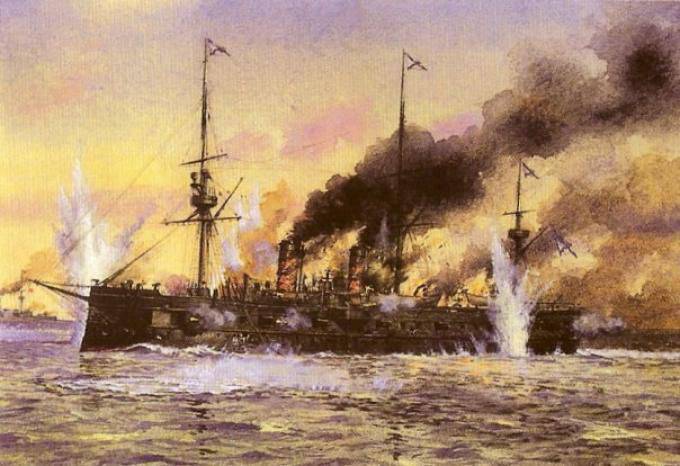
"Dmitry Donskoy"
Only a second-class cruiser Almaz, the destroyers Bravy and Grozny, could leave for Vladivostok. In addition, the transport "Anadyr" went to Madagascar, and then to the Baltic. Three cruisers (“Pearls”, “Oleg” and “Aurora”) went to Manila in the Philippines and were interned there. The destroyer "Bedovy", carrying the wounded Rozhestvensky, was overtaken by Japanese destroyers and surrendered.
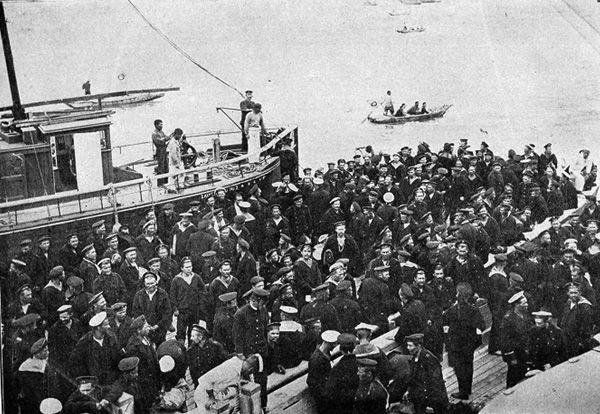
Captured Russian sailors on board the Japanese battleship Asahi
The main causes of the disaster
From the outset, the campaign 2-th Pacific Squadron wore an adventurous nature. Ships had to be sent to the Pacific before the war. Finally, the meaning of the campaign was lost after the fall of Port Arthur and the death of the 1 th Pacific Squadron. From Madagascar squadron had to be returned back. However, due to political ambitions, the desire to somehow raise the prestige of Russia, the fleet was sent to death.
The march from Libava to Tsushima became an unprecedented feat for the Russian sailors to overcome the enormous difficulties, but the battle at Tsushima showed the rottenness of the Romanov Empire. The battle showed the backwardness of the shipbuilding and armament of the Russian fleet in comparison with the advanced powers (the Japanese fleet was created by the efforts of the leading world powers, especially England). Russian naval power in the Far East was crushed. Tsushima was the decisive prerequisite for concluding peace with Japan, although in a military-strategic sense, the outcome of the war was decided on land.
Tsushima has become a kind of scary landmark event for the Russian Empire, showing the need for fundamental changes in the country, the destruction of the war for Russia in its current state. Unfortunately, they did not understand him, and the Russian Empire died as the 2-I Pacific Squadron - bloody and terrible.
One of the main reasons for the death of the squadron was the lack of initiative, the indecision of the Russian command (the scourge of the Russian army and navy during the Russian-Japanese war). Rozhestvensky did not dare to firmly raise the question of sending the squadron back after the fall of Port Arthur. The admiral led the squadron without hope of success and kept passively, giving the initiative to the enemy. There was no specific battle plan. They did not organize further reconnaissance; it was an opportunity to defeat the Japanese cruisers, who had been separated from the main forces for a considerable time and did not use. At the beginning of the battle did not use the chance to deliver a strong blow to the main forces of the enemy. The squadron did not finish combat formation and fought on unfavorable conditions, only lead ships could conduct normal fire. The unsuccessful construction of the squadron allowed the Japanese to focus fire on the best battleships of the Russian squadron and quickly disable them, after which the outcome of the battle was decided. During the battle, when the main battleships failed, the squadron actually fought without command. Nebogatov took command only in the evening and in the morning handed over the ships to the Japanese.
Among the technical reasons, we can single out the "fatigue" of ships after a long march, when they were separated from the normal repair base for a long time. The ships were overloaded with coal and other cargoes, which reduced their seaworthiness. Russian ships were inferior to Japanese ships in the total number of guns, reservation area, speed, speed of fire, weight and explosive power of a squadron shot. A strong backlog was in cruising and bearing forces. The squadron’s ships were varied in armament, protection and maneuverability, which affected its combat capability. New battleships, as the battle showed, had weak reservations and low stability.
The Russian squadron, unlike the Japanese fleet, was not a single combat organism. The personnel, both commanding and private, differed in heterogeneity. Personnel commanders only enough to fill the main positions of responsibility. The incomplete commanding staff was reimbursed due to the early release of the naval corps, the call from the “old men” (who had no experience of walking on armored ships) and the transfer from the merchant fleet (warrant officers). As a result, there was a strong gap between young people who did not have the necessary experience and sufficient knowledge, “old men” who needed to update their knowledge and “civilians” who did not have normal military training. There were also not enough sailors for military service, so about a third of the crews consisted of storekeepers and recruits. There were many “penalty boxers”, whom the commanders “banished” on a long voyage, which did not improve discipline on ships. The situation with the non-commissioned officers was no better. Most of the personnel were assigned to new ships only in the summer of 1904, and could not study the ships well. Due to the fact that it was necessary to finish, repair and prepare ships in an emergency order, the squadron did not go together in the summer of 1904, did not study. Only in August was the 10-day voyage. During the campaign, due to a number of reasons, the crews could not learn to maneuver the ships and shoot well.
Thus, the 2-I Pacific Squadron was poorly prepared, in fact, did not receive combat training. It is clear that Russian sailors and commanders entered the battle courageously, bravely fought, but their heroism could not rectify the situation.
V.S. Ermyshev. Battleship Oslyabya
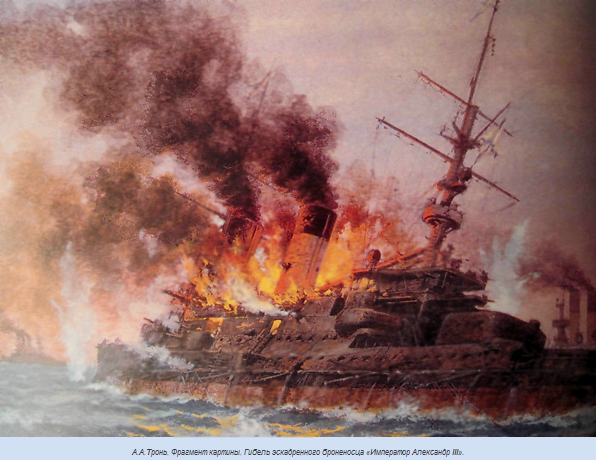
A.Tron The death of the squadron battleship "Emperor Alexander III"
Alexey Novikov, a sailor on the Orel (the future Soviet marine painter), described the situation well. He was arrested in 1903 for revolutionary propaganda and was transferred to the 2 Pacific Squadron as an “unreliable” one. Novikov wrote: “Many sailors were called up from the reserve. These elderly people, who had obviously become disaccustomed to the naval service, lived with memories of their homeland, were sick of separation from their home, with their children, with their wife. The war fell on them unexpectedly, as a terrible disaster, and they, preparing for an unprecedented march, did the work with a gloomy air of strangers. The team consisted of a lot of recruits. 3 are pitiful and miserable, they looked at everything with frozen horror in their eyes. Their scarecrow was the sea, for which they had fallen for the first time, and even more - an unknown future. Even among the personnel sailors who graduated from various special schools, there was no ordinary fun. Only fines, as opposed to the rest, were more or less cheerful. The coastal authorities, in order to get rid of them as a harmful element, came up with the easiest way: to write them off to ships going to war. Thus, to the dismay of the senior officer, we have accumulated up to seven percent. ”
Another good image, explaining the death of the squadron, was given by Novikov (under the pseudonym "sailor A. Zatery"). Here is what he saw: “We were extremely amazed that this ship did not suffer from our artillery at all. He looked as if he had been taken out of the repair right now. Even the paint on the guns did not burn. Our sailors, having examined “Asahi”, were ready to swear that on May 14 we fought not with the Japanese, but ... well, with the British. Inside the battleship we were amazed at the cleanliness, tidiness, practicality and expediency of the device. In our new battleships of the Borodino type, for some thirty officers, a full half of the ship was assigned; it was cluttered with cabins, and they only increased fires during the battle; and in the other half of the ship, we had not only wedged seamen into 900, but also artillery and lifts. And our enemy on the ship, everything was used mainly for guns. Then we were struck by the absence between the officers and the sailors of the discord that you meet with us at every turn; in the same place, on the contrary, some kind of solidarity, kindred spirit and common interests were felt between them. It was only for the first time that we really learned who we were dealing with in battle and what the Japanese are. ”
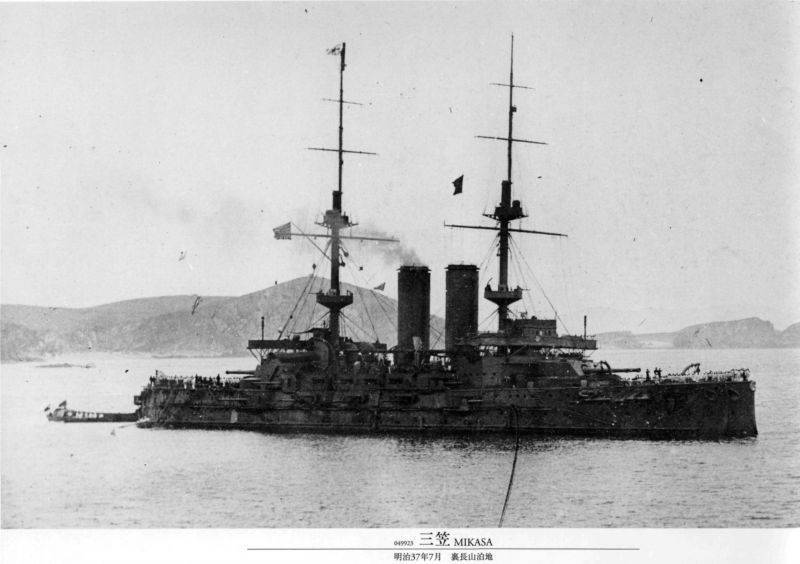
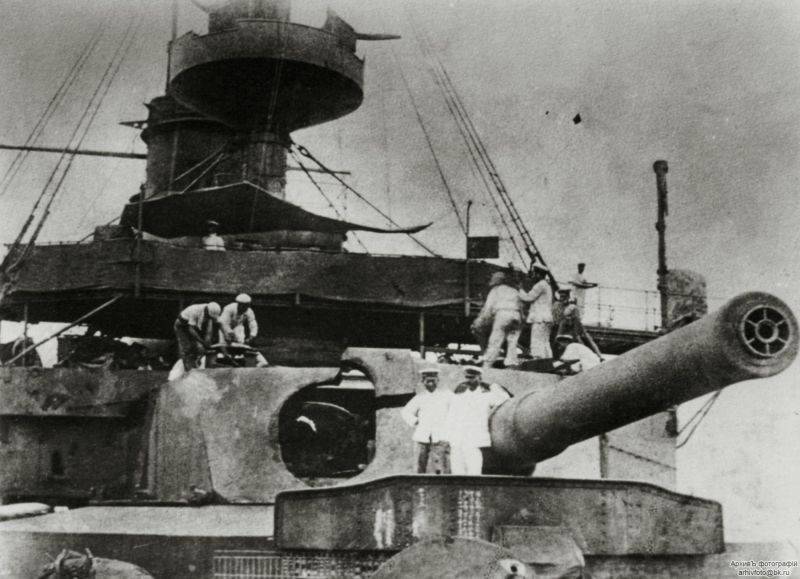
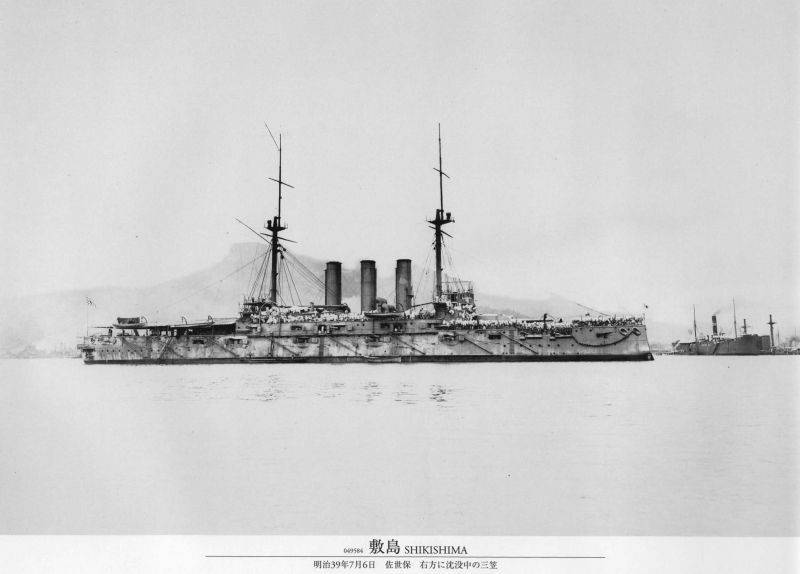
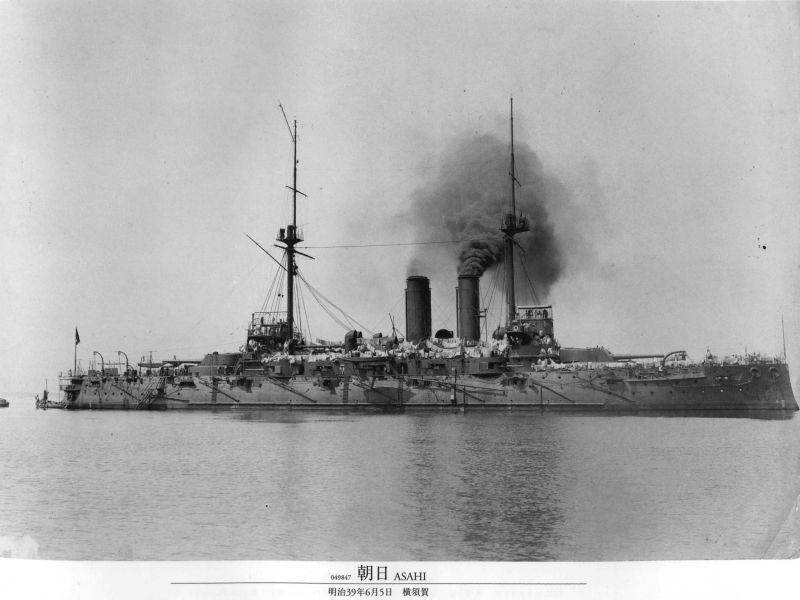
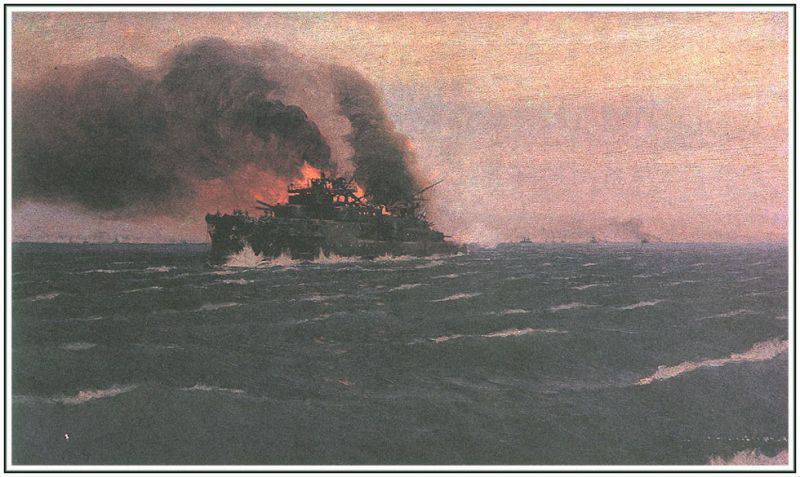
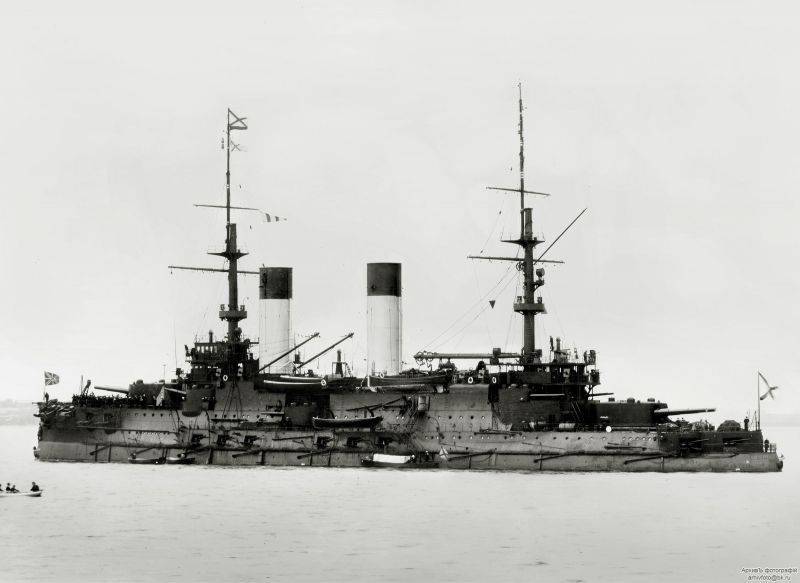
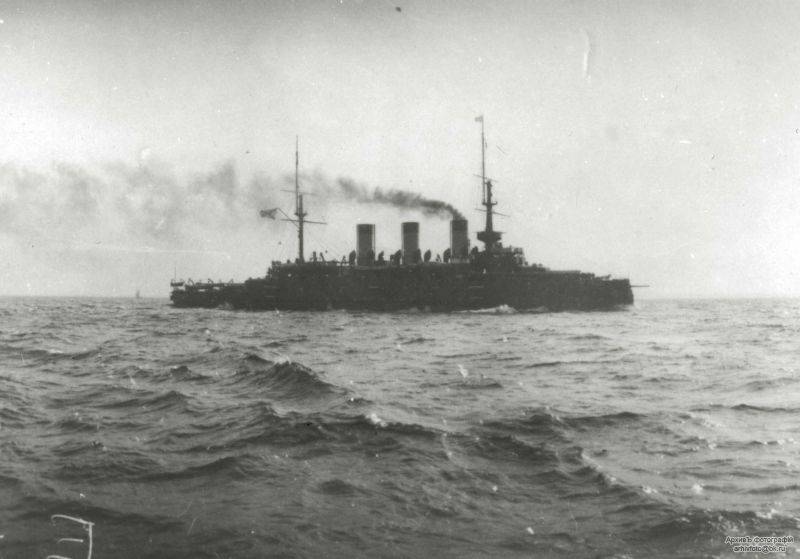
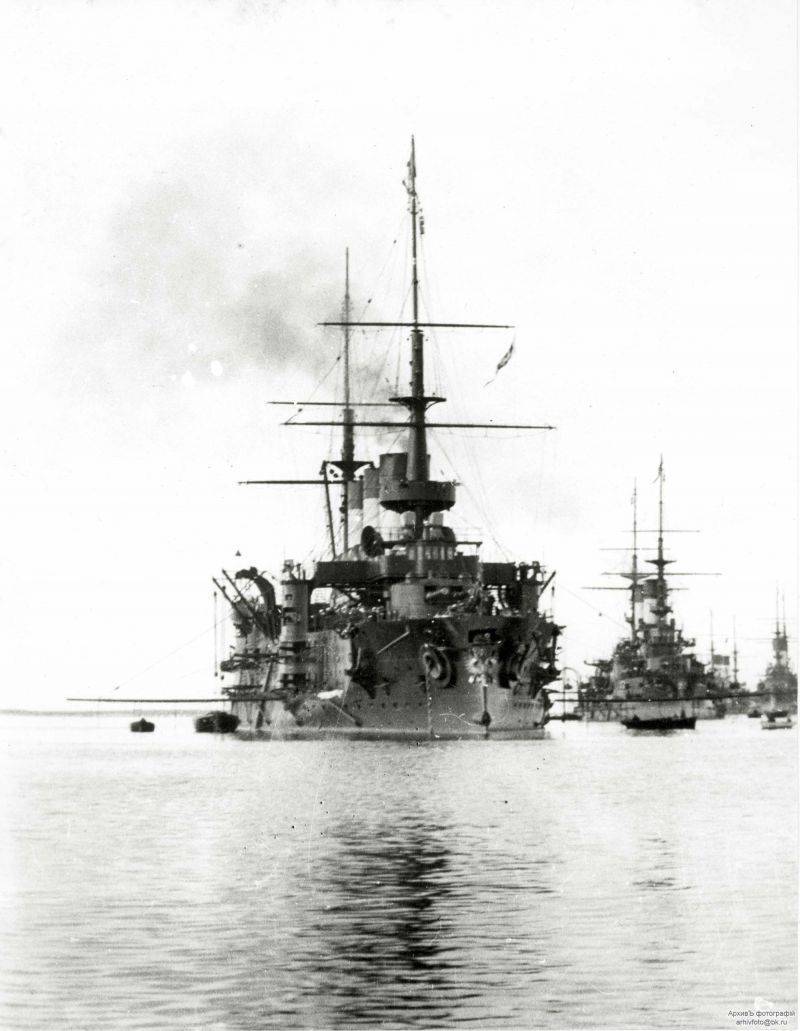
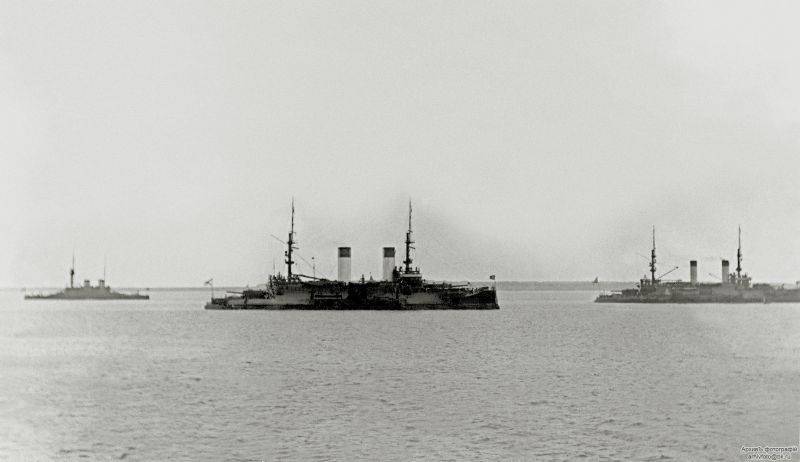
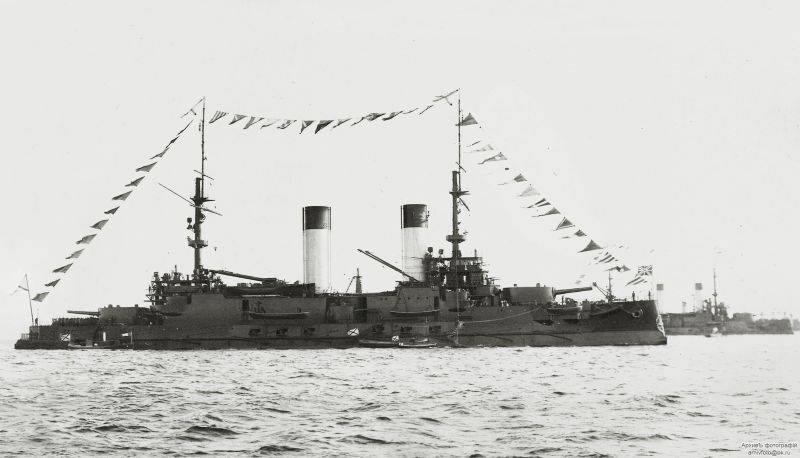
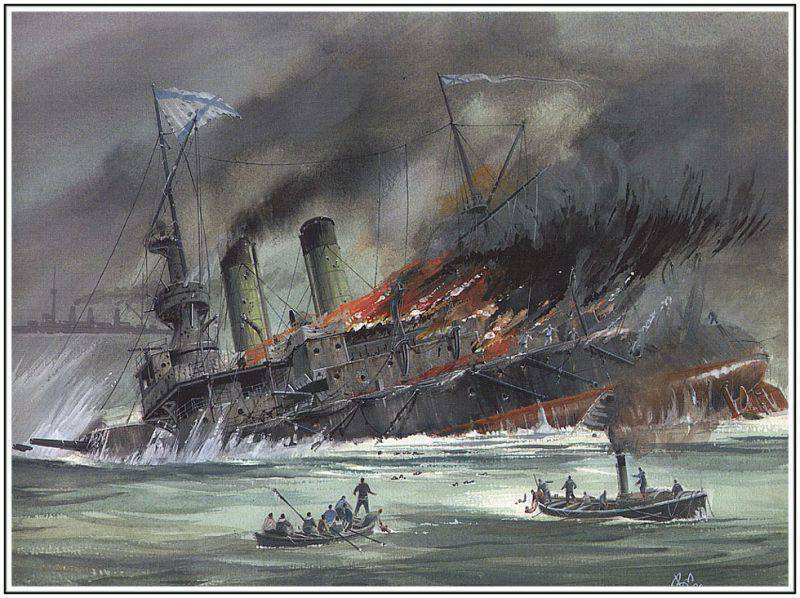
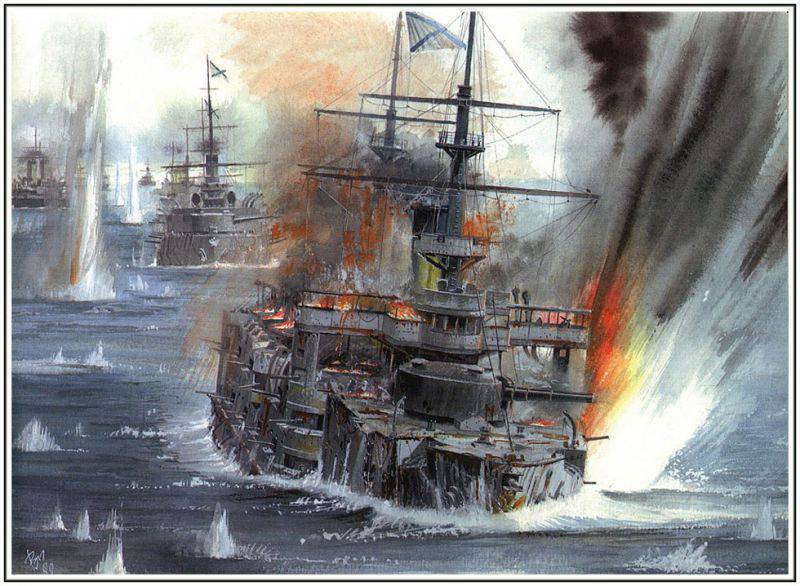
Information